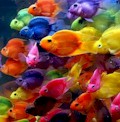Okay, so you have decided that you want to own an aquarium. It is a good idea to make out a wish list before purchasing any fish for the aquarium. Keeping an aquarium will require patience. Unfortunately, it is not realistic to go the pet store and just start picking out fish. Take a trip to the pet store in order to gather information and window shop to determine the types of fish you wish to keep in your aquarium. Carefully research these fish to ensure that they are compatible for water temperatures and P.H., as well as the food that they eat. Be careful not to put prey and predator together in the same tank. Keep in mind that freshwater fish are hardier than the marine variety, and will be less susceptible to water fluctuations.
One reason that freshwater fish are hardier than saltwater fish is the saltwater itself. Just like any living creature, a fish's body requires water in order to function properly. Water is absorbed through a fish's skin in the freshwater environment. Alternatively, a saltwater fish actually has to drink the salt water, because the body fluids are extracted through the skin by osmosis. The salt is then excreted in the form of highly concentrated urine. Freshwater fish are a good choice for an inexperienced aquarium owner because there is more wiggle room in the water specifications. Some freshwater fish have a variation of as much as ten degrees of acceptable water temperature. Conversely, most tropical fish will only allow about two degrees of variation in water temperature.
It is not uncommon for the novice fish keeper to become easily discouraged. Water conditions are hard to regulate and unfortunately fish, even the freshwater variety, are not the hardiest of creatures. Sometimes they do not survive these fluctuations. It is important to be patient. An aquarium needs to run for a minimum of twenty four hours before adding any fish at all. You may want to allow the tank to run and filter with decorations and any plant life for a few days before introducing the fish. Be sure to clean the decorations and any substrate thoroughly before adding them to the aquarium. Live plants are highly recommended in new aquariums as they will help to generate the good bacteria necessary to reduce the amount of ammonia in the tank. It is a good idea to test the ammonia and nitrite levels before adding fish to the aquarium. Begin by adding only three to four small fish. A general rule is to wait another thirty days before adding additional fish, because that is the incubation period for most fish illnesses. In addition, test the nitrite and ammonia levels before adding these additional fish. The ammonia levels should return to zero. This also takes about a month.
There are a few basic tips that will keep fish healthy. Don't over feed the fish. Any excess food will become debris in the tank, and then turns into ammonia, which is toxic to fish. Change the water in the aquarium regularly. Replace approximately one third of the water in the tank every two to three weeks. This will minimize the disruption to the fish in the aquarium, eliminating the need to remove the fish from the tank. Lastly, don't forget to clean the filter. Follow the manufacturer's instructions, as some filters need to be replaced more frequently than others.

